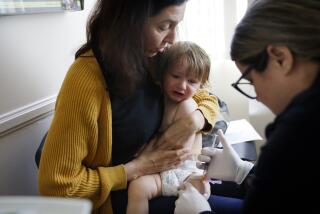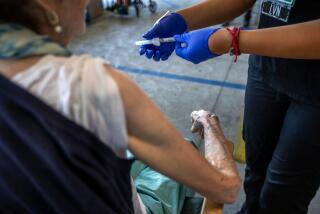Cervical cancer vaccine gains acceptance in California
The cervical cancer vaccine Gardasil is gaining widespread acceptance in California despite its newness and some controversy over its safety, UCLA researchers have found.
One in four teenage girls in the state -- about 378,000 out of 1.5 million -- received at least one dose of the vaccine in 2007, its first full year of distribution, according to the report, released Tuesday by UCLA’s Center for Health Policy Research.
Among those who had not started the series of shots, a majority of teens and young adult women expressed interest in receiving the vaccine, as did their parents, the survey found.
Gardasil provides protection against four strains of the human papilloma virus, which are associated with about 70% of all cervical cancers in the United States and 90% of genital warts. The vaccine is administered in three shots over a six-month period.
Uncertainty and safety concerns typically surround the introduction of any new vaccine, and Gardasil has been more controversial than most. In March 2007, the national Centers for Disease Control and Prevention recommended the newly licensed vaccine for 11- and 12-year-old girls and beyond, up to age 26. (The vaccine works best if given before a young woman is sexually active and may have already contracted the virus.)
The recommendation sparked a flurry of objections, both scientific and social.
Critics said that the vaccine, approved in June 2006, was too new for its long-term effectiveness and safety to be judged. Others said that it was too expensive and that it was unnecessary because an effective cervical cancer screening method, the Pap smear, exists already. And some parents said that giving it to young girls implies approval of premarital sex.
A large study published last year alleviated some safety concerns, finding only three confirmed allergic reactions in girls and young women who received the vaccine in Australia. And the CDC seal of approval prompted U.S. programs for the poor as well as many private insurance plans to cover the cost.
The study, the first to look at Gardasil vaccination rates within a single state, was based on a large database called the California Health Interview Survey, in which more than 50,000 Californians are periodically interviewed by phone. The UCLA researchers said they would soon release additional data on how different ethnic and socioeconomic groups have complied with the recommendation.
Preliminary results showed few differences by race, ethnicity or economic status among adolescent girls, said sociologist David Grant, the survey director. The federal Vaccines for Children program provides free shots for those without insurance in this age group.
But in the older age group -- age 18 to 26 -- fewer Latinas and African American women got vaccinations. This could be because coverage for the vaccine would not be automatic in this group, Grant said.
The researchers said they were surprised to see high levels of Gardasil awareness and acceptance, which Grant attributes to aggressive marketing by Merck & Co., which makes the vaccine.
“It’s hard to open a magazine targeted to young women and not see an ad for Gardasil,” Grant said.
--






